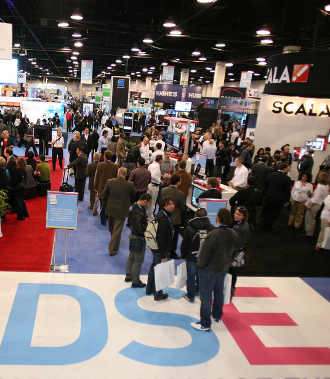A week removed from DSE and I’m head deep into preparing for SXSW (we support one of our clients – Chevrolet – for their SXSW Super Sponsorship). Next week, the activation that I’m leading kicks off as 10 teams from North America roadtrip down to Austin and document their journeys. The timing of DSE & SXSW presents many challenges for me, but it’s all about balance, right?
I’ve had time to reflect on my three days at DSE and now, I’m finding the time to document it. So, here you go, today’s Friday 4-1-1 is dedicated to my takeaways.
1. Non-digital signage player keynotes are good – Shelly Palmer – someone who has nothing to do with digital signage – gave the keynote address. He spoke about how technology has changed our way of life (speed and scale) and loosely tied it to the digital signage industry. I thought it was refreshing, and even more, I thought it was important for the audience to hear someone a) removed from the industry and b) in tune with how consumers consume media and connect with each other through technology. He made a lot of great points and I really hope the majority of that audience walked out of the room as jazzed as I did. He was good. He doesn’t have a stake in the industry, per se, but certainly has a worthwhile perspective, given his knowledge and expertise. The nut of his presentation – technology is meaningless unless it changes the way we behave. I think it’s a great filter for everyone in the digital signage industry – does your solution change the way people behave? If not, what can you do to the solution to make it so?
2. The digital signage industry is not cutting edge in daily practice – This is definitely a general statement, but one of the questions that Shelly Palmer asked in his keynote was “how many of the audience has their information feeds set up through something like Google Reader?” And, at best, 10% of the audience raised their hands. I just find it ironic that an industry thought of as an emerging one does not apply some of the fundamental practices of the digital world. For those of you who don’t have feeds set up, Google Reader is a simple and effective tool. Go there, copy and paste your favorite URL’s and start getting all of that content in one single place. More than it being an aggregator for all of my favorite sites, I use it as a monitoring tool for trends and issues. For anyone who is creating a product that consumers will ultimately consume, it’s essential that you understand how they’re using like products and/or what they’re saying about them and/or who’s saying it. Google Reader is a great way to start understanding all of that information.
3. The “Content is King” talk is cheap – I can’t tell you how many times I heard “content is king” from different people. To everyone’s credit this year, I didn’t hear a peep of that last year. So, there is wide-spread recognition in the industry that content is important. But what’s new? Content is the thing. It always will be. For all of the talk about content, I didn’t see much of it from anyone on the showroom floor. Again, I’m left scratching my head. Nothing – in and out of this industry – is about technology. Technology is a means to an end and it can certainly change the way that we behave. But there is nothing more important than content. Never will be. So, can we all stop it with this phrase? It’s buzzed to the point of being laughable.
4. Relationships trump everything – I mean, if anything is the “king,” it’s relationships. Without relationships, nothing is sustainable. I am so thankful for all of the relationships I’ve been able to form in this industry. It’s filled with great people. To me, the best thing about DSE was connecting and re-connecting with those I know and met for the first time. Way better than any session and/or anything I saw on the showroom floor. If you want to focus on one thing at a conference like this, you can’t go wrong with focusing on the people. All else pales in comparison.
“Uh-huh” – The show organizers are great. Thank you, again, to Gerri. I will forever be grateful to you. Angelo and Chris – thank-you as well. And to those sweet, stand-your-ground hosts of the blogger lounge – you rock.
“Duh” – My golf game needs a little bit of help. I didn’t do bad for not playing in 2 years. But, if they do it again next year, and my team accepts me back, I’ll play a couple of practice rounds before-hand.
All in all, it was a great show. I saw lots of improvements over last year. They’re really trying to put the focus on content and interactivity and pull new people in to this. They’ve done a great job with their approach to education throughout the year, and you could feel it at the show. There’s a fairly long road to go, but they’ve got great minds trying to push this into something that is attractive and valuable for everyone outside of the industry.
Thanks, as always, for reading. Happy weekend!












